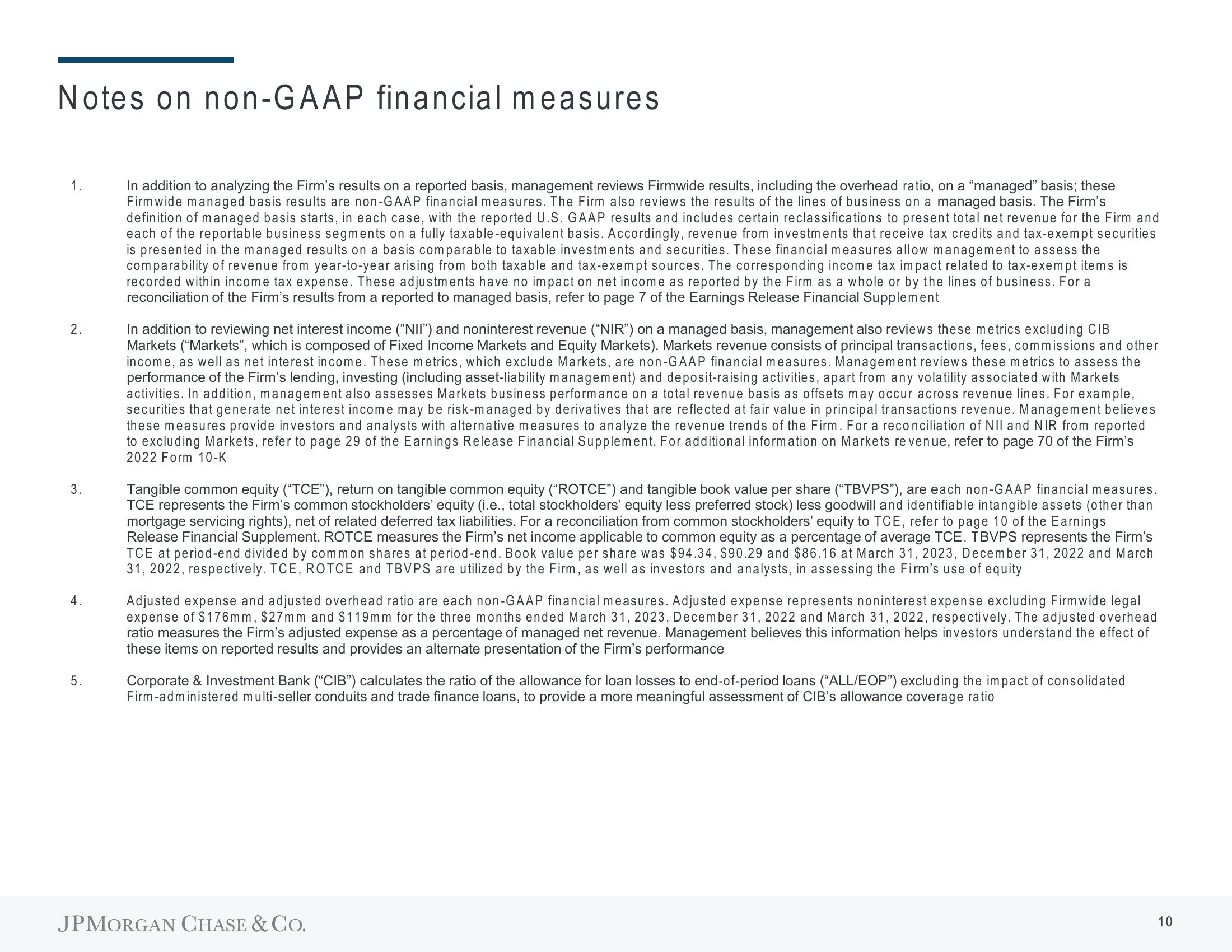J.P.Morgan Results Presentation Deck
Notes on non-GAAP financial measures
1.
2.
3.
4.
5.
In addition to analyzing the Firm's results on a reported basis, management reviews Firmwide results, including the overhead ratio, on a "managed" basis; these
Firmwide managed basis results are non-GAAP financial measures. The Firm also reviews the results of the lines of business on a managed basis. The Firm's
definition of managed basis starts, in each case, with the reported U.S. GAAP results and includes certain reclassifications to present total net revenue for the Firm and
each of the reportable business segments on a fully taxable-equivalent basis. Accordingly, revenue from investments that receive tax credits and tax-exempt securities
is presented in the managed results on a basis comparable to taxable investments and securities. These financial measures allow management to assess the
comparability of revenue from year-to-year arising from both taxable and tax-exempt sources. The corresponding income tax impact related to tax-exempt items is
recorded within income tax expense. These adjustments have no impact on net income as reported by the Firm as a whole or by the lines of business. For a
reconciliation of the Firm's results from a reported to managed basis, refer to page 7 of the Earnings Release Financial Supplement
In addition to reviewing net interest income ("NII") and noninterest revenue ("NIR") on a managed basis, management also reviews these metrics excluding CIB
Markets ("Markets", which is composed of Fixed Income Markets and Equity Markets). Markets revenue consists of principal transactions, fees, commissions and other
income, as well as net interest income. These metrics, which exclude Markets, are non-GAAP financial measures. Management reviews these metrics to assess the
performance of the Firm's lending, investing (including asset-liability management) and deposit-raising activities, apart from any volatility associated with Markets
activities. In addition, management also assesses Markets business performance on a total revenue basis as offsets may occur across revenue lines. For example,
securities that generate net interest income may be risk-managed by derivatives that are reflected at fair value in principal transactions revenue. Management believes
these measures provide investors and analysts with alternative measures to analyze the revenue trends of the Firm. For a reconciliation of NII and NIR from reported
to excluding Markets, refer to page 29 of the Earnings Release Financial Supplement. For additional information on Markets revenue, refer to page 70 of the Firm's
2022 Form 10-K
Tangible common equity ("TCE"), return on tangible common equity ("ROTCE") and tangible book value per share ("TBVPS"), are each non-GAAP financial measures.
TCE represents the Firm's common stockholders' equity (i.e., total stockholders' equity less preferred stock) less goodwill and identifiable intangible assets (other than
mortgage servicing rights), net of related deferred tax liabilities. For a reconciliation from common stockholders' equity to TCE, refer to page 10 of the Earnings
Release Financial Supplement. ROTCE measures the Firm's net income applicable to common equity as a percentage of average TCE. TBVPS represents the Firm's
TCE at period-end divided by common shares at period-end. Book value per share was $94.34, $90.29 and $86.16 at March 31, 2023, December 31, 2022 and March
31, 2022, respectively. TCE, ROTCE and TBVPS are utilized by the Firm, as well as investors and analysts, in assessing the Firm's use of equity
Adjusted expense and adjusted overhead ratio are each non-GAAP financial measures. Adjusted expense represents noninterest expense excluding Firm wide legal
expense of $176mm, $27mm and $119mm for the three months ended March 31, 2023, December 31, 2022 and March 31, 2022, respectively. The adjusted overhead
ratio measures the Firm's adjusted expense as a percentage of managed net revenue. Management believes this information helps investors understand the effect of
these items on reported results and provides an alternate presentation of the Firm's performance
Corporate & Investment Bank ("CIB") calculates the ratio of the allowance for loan losses to end-of-period loans ("ALL/EOP") excluding the impact of consolidated
Firm-administered multi-seller conduits and trade finance loans, to provide a more meaningful assessment of CIB's allowance coverage ratio
JPMORGAN CHASE & CO.
10View entire presentation